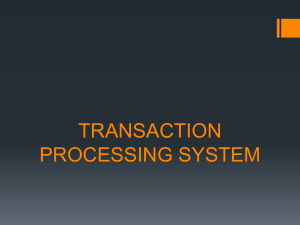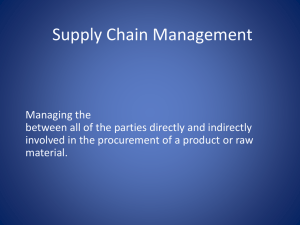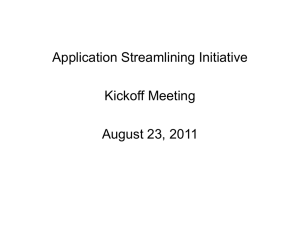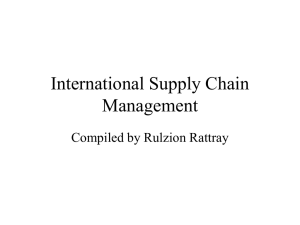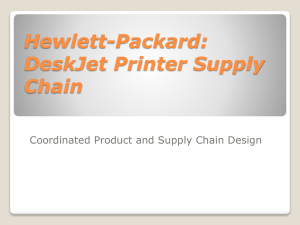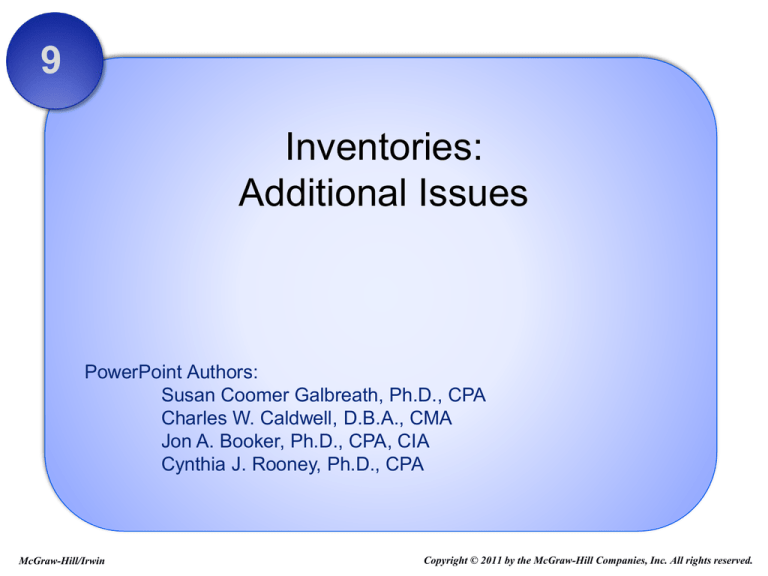
9
Inventories:
Additional Issues
PowerPoint Authors:
Susan Coomer Galbreath, Ph.D., CPA
Charles W. Caldwell, D.B.A., CMA
Jon A. Booker, Ph.D., CPA, CIA
Cynthia J. Rooney, Ph.D., CPA
McGraw-Hill/Irwin
Copyright © 2011 by the McGraw-Hill Companies, Inc. All rights reserved.
Reporting -- Lower of Cost or Market
Inventories are valued at the lowerof-cost-or market.
LCM is a departure from historical cost. The method
causes losses to be recognized in the period the value
of inventory declines below its cost rather than in the
period that the goods ultimately are sold.
9-2
Determining Market Value
GAAP defines
“market value” in
terms of current
replacement cost.
Market should not be
greater than the
“ceiling” or less than
the “floor.”
9-3
Market Should Not
Exceed Net Realizable
Value (Ceiling)
Market Should Not Be
Less Than Net Realizable
Value less Normal Profit
(Floor)
Determining Market Value
Step 1
Determine Designated Market
Step 2
Compare Designated Market with Cost
Ceiling
NRV
Not More Than
Replacement
Cost
Designated
Market
Or
Not Less Than
Lower of Cost
Or Market
NRV – NP
Floor
9-4
Cost
Lower of Cost or Market
• An item in inventory has a historical cost
of $20 per unit. At year-end we gather
the following per unit information:
•
•
•
•
current replacement cost = $21.50
selling price = $30
cost to complete and dispose = $4
normal profit margin of = $5
• How would we value this item in the
Balance Sheet?
9-5
Lower of Cost or Market
Selling
Cost to
= Ceiling
Price
Complete
$ 30.00 - $
4.00 = $ 26.00
Replacement
Cost =$21.50
Normal
= Floor
Profit
$ 26.00 - $
5.00 = $ 21.00
Ceiling
9-6
-
Designated
$21.50
Market?
Historical cost of $20.00 is
less than designated
market of $21.50, so this
inventory item will be
valued at cost of $20.00.
Applying Lower of Cost or Market
Lower of cost or market can be applied 3
different ways.
3.1.Apply
Apply
2. Apply
LCM
LCM
LCM
to
tothe
each
to entire
logical
individual
inventory
inventory
itemasina
categories.
inventory.
group.
9-7
Adjusting Cost to Market
1. Record the Loss as a Separate Item in
the Income Statement
Loss on write-down of inventory
Inventory
XX
XX
2. Record the Loss as part of Cost of Goods
Sold.
Cost of goods sold
Inventory
9-8
XX
XX
U. S. GAAP vs. IFRS
International standards require inventory to be valued at
the lower of cost or market, but the process is slightly
different for the U.S. method of applying LCM.
• LCM requires selecting market
from replacement cost, net
realizable value or NRV
reduced by the normal profit
margin.
• Designated market is
compared to historical cost to
determine LCM.
9-9
• IAS No. 2, states that the
designated market will always
be net realizable value.
U. S. GAAP vs. IFRS
International standards require inventory to be valued at
the lower of cost or market, but the process is slightly
different for the U.S. method of applying LCM.
• Under U.S. GAAP, the LCM
rule can be applied to
individual items, logical
inventory categories, or the
entire inventory.
• Reversals are not permitted
under GAAP.
9 - 10
• The LCM assessment usually
is applied to individual items,
although using logical
inventory categories is allowed
under certain circumstances.
• If an inventory write-down is
not longer appropriate, it must
be reversed.
Inventory Estimation Techniques
Estimate instead of taking physical inventory
1. Less costly
2. Less time consuming
Two popular methods of estimating ending
inventory are the . . .
1. Gross Profit Method
2. Retail Inventory Method
9 - 11
Gross Profit Method
Estimating inventory
and COGS for interim
reports.
Auditors are testing the
overall reasonableness
of client inventories.
Useful
when . . .
Determining the cost of
inventory lost,
destroyed, or stolen.
Preparing budgets and
forecasts.
NOTE: The Gross Profit Method is not acceptable
for use in annual financial statements.
9 - 12
Gross Profit Method
This method assumes that the historical gross
margin ratio is reasonably constant in the short-run.
Beginning Inventory
Plus: Net purchases
Goods available for sale
Less: Cost of goods sold
Ending inventory
(from accounting records)
(from accounting records)
(calculated)
(estimated)
(estimated)
Estimate the Historical Gross Profit Ratio
9 - 13
Gross Profit Method
Matrix, Inc. uses the gross profit method to estimate
end of month inventory. At the end of May, the
controller has the following data:
1.
2.
3.
4.
Net sales for May = $1,213,000
Net purchases for May = $728,300
Inventory at May 1 = $237,400
Estimated gross profit ratio = 43% of sales
Estimate Inventory at May 31.
9 - 14
Gross Profit Method
Beginning Inventory
Plus: Net Purchases
= Goods Available for Sale
Less: Estimated COGS*
= Estimated Ending Inventory
$
237,400
728,300
965,700
(691,410)
$ 274,290
* COGS = Sales x (1 - GP%) = $ 1,213,000 x ( 1 - 43% )
= $ 691,410
NOTE: The key to successfully applying this
method is a reliable Gross Profit Ratio.
9 - 15
The Retail Inventory Method
• This method was developed for retail
operations like department stores.
• Uses both the retail value and cost of
items for sale to calculate a cost to retail
percentage.
Objective: Convert ending inventory at
retail to ending inventory at cost.
9 - 16
The Retail Inventory Method
Retail Terminology
Term
Initial markup
Additional markup
Markup cancellation
Markdown
Markdown cancellation
9 - 17
Meaning
Original amount of markup from cost to selling price.
Increase in selling price subsequent to initial markup.
Elimination of an additional markup.
Reduction in selling price below the original selling price.
Elimination of a markdown.
The Retail Inventory Method
Beginning inventory at
retail and cost.
Sales for the period.
We need to
know . . .
Net purchases at retail
and cost.
9 - 18
Adjustments to the
original retail price.
Retail Terminology
An Example of the Terminology
9 - 19
The Retail Inventory Method
Matrix, Inc. uses the retail method to estimate
inventory at the end of each month. For the month of
May the controller gathers the following information:
1) Beginning inventory at cost $27,000, at retail
$45,000
2) Net purchases at cost $180,000 at retail
$300,000
3) Net sales for May $310,000
Estimate the inventory at May 31.
9 - 20
The Retail Inventory Method
Inventory, May 1
Net purchases for May
Goods available for sale
Cost-to-Retail Percentage:
(207,000 ÷ 345,000) = 60%
Sales for May
Ending inventory at retail
Ending inventory at cost
9 - 21
Cost
Retail
$ 27,000 $ 45,000
180,000
300,000
207,000
345,000
(310,000)
$ 35,000
?
The Retail Inventory Method
Cost
Retail
$ 27,000 $ 45,000
180,000
300,000
207,000
345,000
Inventory, May 1
Net purchases for May
Goods available for sale
Cost-to-Retail Percentage:
(207,000 ÷ 345,000) = 60%
Sales for May
Ending inventory at retail
Ending inventory at cost
$
9 - 22
×
x
21,000
(310,000)
$ 35,000
The Retail Inventory Method
We can estimate ending inventory at
average LCM using the cost-to-retail
percentage shown below:
Cost-toRetail %
=
Beginning Inventory + Net Purchases
Retail Value (Beginning Inventory + Net
Purchases + Net Markups)
Net Markdowns are excluded in the computation of
the cost-to-retail percentage. This is referred to as the
Conventional Retail Method
9 - 23
The Retail Inventory Method
The LIFO Retail Method
• Assume that retail prices of goods remain stable
during the period.
• Establish a LIFO base layer (beginning inventory)
and add (or subtract) the layer from the current
period.
• Calculate the cost-to-retail percentage for
beginning inventory and for adjusted net
purchases for the period.
9 - 24
The Retail Inventory Method
The LIFO Retail Method
LIFO Cost- =
to-Retail %
Net Purchases
Retail Value (Net Purchases
+ Net Markups - Net Markdowns)
Beginning inventory has its own
cost-to-retail percentage.
9 - 25
Retail Inventory Method
LIFO Retail
Cost
Inventory, July 1 ($21,000 ÷ $35,000 = 60% ) $ 21,000
Plus: Net Purchases
200,000
Net Markups
Less: Net Markdowns
Purchases for July
200,000
($200,000 ÷ $308,000 = 64.94% rounded
9 - 26
Retail
$ 35,000
304,000
8,000
(4,000)
308,000
Retail Inventory Method
LIFO Retail
Cost
Inventory, July 1 ($21,000 ÷ $35,000 = 60% ) $ 21,000
Plus: Net Purchases
200,000
Net Markups
Less: Net Markdowns
Purchases for July
200,000
($200,000 ÷ $308,000 = 64.94% rounded
Sales for July
LIFO layer for July
9 - 27
Retail
$ 35,000
304,000
8,000
(4,000)
308,000
(300,000)
8,000
Retail Inventory Method
LIFO Retail
Inventory, July 1 ($21,000 ÷ $35,000 = 60% )
Plus: Net Purchases
Net Markups
Less: Net Markdowns
Goods available for sale
($200,000 ÷ $308,000 = 64.94% rounded
Sales for July
LIFO layer for July
Beginning Inventory
Current Period's Layer
Total
** rounded
9 - 28
Cost
Retail
$ 21,000
200,000
$ 35,000
304,000
8,000
(4,000)
308,000
200,000
Retail
$
35,000 x 60.00% =
8,000 x 64.94% =
$
43,000
(300,000)
8,000
Cost
21,000
5,195 **
26,195
Changes in Inventory Method
Recall that most voluntary changes in
accounting principles are reported
retrospectively. This means reporting all
previous periods’ financial statements as
though the new method had been used in
all prior periods.
Changes in inventory methods, other than a
change to LIFO, are treated retrospectively.
9 - 29
Change To The LIFO Method
When a company elects to change to LIFO, it is
usually impossible to calculate the income effect
on prior years. As a result, the company does not
report the change retrospectively. Instead, the LIFO
method is used from the point of adoption forward.
A disclosure note is needed to explain (a) the
nature of the change; (b) the effect of the
change on current year’s income and
earnings per share, and (c) why retrospective
application was impracticable.
9 - 30
Analyzing Inventory Errors
9 - 31
Inventory Errors
Overstatement of ending inventory
◦ Understates cost of goods sold and
◦ Overstates pretax income.
Understatement of ending inventory
◦ Overstates cost of goods sold and
◦ Understates pretax income.
9 - 32
Inventory Errors
Overstatement of beginning inventory
◦ Overstates cost of goods sold and
◦ Understates pretax income.
Understatement of beginning inventory
◦ Understates cost of goods sold and
◦ Overstates pretax income.
9 - 33
Inventory Errors
When the Inventory Error is Discovered the Following Year
If an error was made in 2010, but not discovered until 2011, the 2010
financial statements were incorrect as a result of the error. The error
should be retrospectively restated to reflect the correct inventory amount,
cost of goods sold, net income, and retained earnings when the
comparative 2011 and 2010 financial statements are issued in 2011.
When the Inventory Error is Discovered Subsequent
to the Following Year
If an error was made in 2010, but not discovered until 2012, the 2011
financial statements also are retrospectively restated to reflect the correct
cost of goods sold and net income even though no correcting entry is
needed. The error has self-corrected and no prior period adjustment is
needed.
9 - 34
Inventory Errors
Overstatement of purchases
◦ Overstates cost of goods sold and
◦ Understates pretax income.
Understatement of purchases
◦ Understates cost of goods sold and
◦ Overstates pretax income.
9 - 35
Earnings Quality
Many believe that manipulating income reduces
earnings quality because it can mask permanent
earnings. Inventory write-downs and changes in
inventory method are two additional inventoryrelated techniques a company could use to
manipulate earnings.
9 - 36



